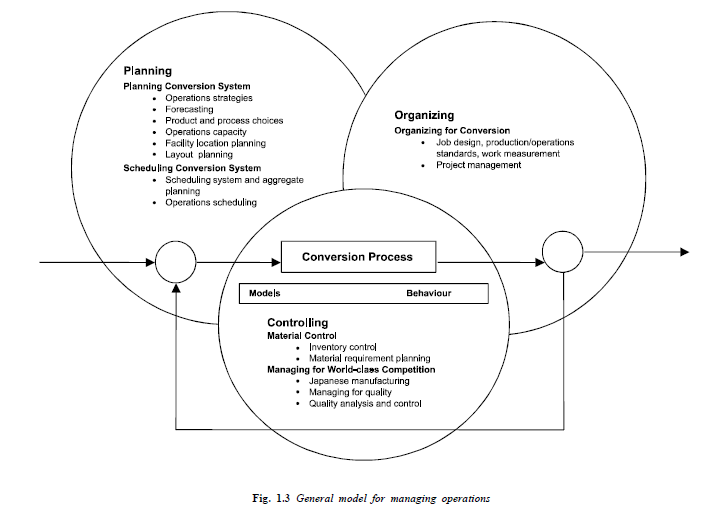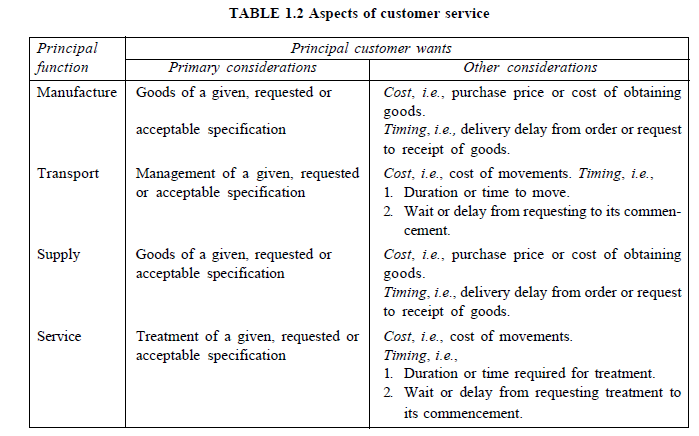1. A Framework for Managing Operations
Managing operations can be enclosed in a frame of general management function as shown in Fig. 1.3. Operation managers are concerned with planning, organizing, and controlling the activities which affect human behaviour through models.
1.1. Planning
Activities that establishes a course of action and guide future decision-making is planning.
The operations manager defines the objectives for the operations subsystem of the organization, and the policies, and procedures for achieving the objectives. This stage includes clarifying the role and focus of operations in the organization’s overall strategy. It also involves product planning, facility designing and using the conversion process.
1.2. Organizing
Activities that establishes a structure of tasks and authority. Operation managers establish a structure of roles and the flow of information within the operations subsystem. They determine the activities required to achieve the goals and assign authority and responsibility for carrying them out.
1.3. Controlling
Activities that assure the actual performance in accordance with planned performance. To ensure that the plans for the operations subsystems are accomplished, the operations manager must exercise control by measuring actual outputs and comparing them to planned operations management. Controlling costs, quality, and schedules are the important functions here.
1.4. Behaviour
Operation managers are concerned with how their efforts to plan, organize, and control affect human behaviour. They also want to know how the behaviour of subordinates can affect management’s planning, organizing, and controlling actions. Their interest lies in decision-making behaviour.
1.5. Models
As operation managers plan, organise, and control the conversion process, they encounter many problems and must make many decisions. They can simplify their difficulties using models like aggregate planning models for examining how best to use existing capacity in short-term, break even analysis to identify break even volumes, linear programming and computer simulation for capacity utilisation, decision tree analysis for long-term capacity problem of facility expansion, simple median model for determining best locations of facilities etc.

2. Objectives of Operations Management
Objectives of operations management can be categorised into customer service and resource utilisation.
2.1. Customer Service
The first objective of operating systems is the customer serivce to the satisfaction of customer wants. Therefore, customer service is a key objective of operations management. The operating system must provide something to a specification which can satisfy the customer in terms of cost and timing. Thus, primary objective can be satisfied by providing the ‘right thing at a right price at the right time’.
These aspects of customer service—specification, cost and timing—are described for four functions in Table 1.2. They are the principal sources of customer satisfaction and must, therefore, be the principal dimension of the customer service objective for operations managers.

Generally an organization will aim reliably and consistently to achieve certain standards and operations manager will be influential in attempting to achieve these standards. Hence, this objective will influence the operations manager’s decisions to achieve the required customer service.
2.2. Resource Utilisation
Another major objective of operating systems is to utilise resources for the satisfaction of customer wants effectively, i.e., customer service must be provided with the achievement of
effective operations through efficient use of resources. Inefficient use of resources or inadequate customer service leads to commercial failure of an operating system.
Operations management is concerned essentially with the utilisation of resources, i.e., obtaining maximum effect from resources or minimising their loss, under utilisation or waste. The extent of the utilisation of the resources’ potential might be expressed in terms of the proportion of available time used or occupied, space utilisation, levels of activity, etc. Each measure indicates the extent to which the potential or capacity of such resources is utilised. This is referred as the objective of resource utilisation.
Operations management is also concerned with the achievement of both satisfactory customer service and resource utilisation. An improvement in one will often give rise to deterioration in the other. Often both cannot be maximised, and hence a satisfactory performance must be achieved on both objectives. All the activities of operations management must be tackled with these two objectives in mind, and many of the problems will be faced by operations managers because of this conflict. Hence, operations managers must attempt to balance these basic objectives.
Table 1.3 summarises the twin objectives of operations management. The type of balance established both between and within these basic objectives will be influenced by market considerations, competitions, the strengths and weaknesses of the organization, etc. Hence, the operations managers should make a contribution when these objectives are set.

Source: KumarAnil, Suresh N. (2009), Production and operations management, New Age International Pvt Ltd; 2nd Ed. edition.

Someone necessarily lend a hand to make critically articles I might
state. This is the first time I frequented your web page and thus far?
I surprised with the research you made to create this actual put up incredible.
Wonderful job!
This is very interesting, You’re a very skilled blogger. I’ve joined your feed and look forward to seeking more of your wonderful post. Also, I have shared your web site in my social networks!